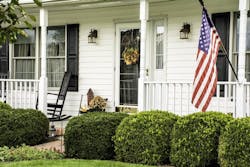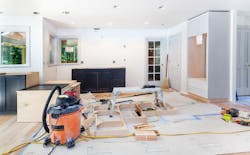Architects Say Multigenerational Housing and Backlogs Are Surging
The American Institute of Architects’ (AIA) fourth quarter survey found an increase in homes designed for multiple generations under one roof, in addition to a growing desire for porches.
The latest Home Design Trends Survey, which focused on community and neighborhood design, reported strong growth for custom homes and an overall impressive rebound from 2020’s first quarter. Numbers of backlogs reported in the survey also point toward a busy road ahead in the residential sector.
AIA cites the pandemic as the leading cause of this jump in the popularity of multigenerational housing. It could be the economic benefits of multiple income earners in the same home, granting the ability to split household costs, or even the health concerns with senior care facilities, says Realtor.com.
Either way, multigenerational households were increasing in popularity before the pandemic, but it certainly accelerated the trend. According to the AIA study, multigenerational home requests leaped double-digits from 2019 to 2020.
In 2019, the percentage of respondents reporting the popularity of multigenerational housing hit 41%. In 2020, it hit 54%.
Another big change is the significant drop in higher-density development, which dropped to 34% in 2020 from 55% in 2019. Infill development hit a hurdle as well, according to the study, with a 5% decrease in popularity in 2020.
[ Read More: BATHROOM DESIGN TRENDS COMING IN 2021 ]
Home Styles
When it comes to home styles, AIA’s study identified several trends that are seeing big changes.
Single-story homes grew 11% in popularity in 2020, which could coincide with the demand for multigenerational living, increased awareness of accessibility, and aging in place.
Front and side porches gained the most momentum in 2020, though, with an 8% increase in popularity. Because more Americans are staying home more often, more turned their attention to their backyards, gardens, pools, and outdoor kitchens.
Modern farmhouse home design continues to dwindle with an 8% drop in popularity from 2019 to 2020, while contemporary home styles reign supreme. Contemporary homes saw a slight 4% decrease in 2020, but remains most popular at 50%.
[ Read More: 5 THINGS YOU SHOULD KNOW ABOUT WELLNESS DESIGN ]
Home Exteriors
What AIA’s study tells readers is that homeowners want long lifespans and minimal work.
Low maintenance and durable exterior products are the most desired by homeowners, according to the respondents. Even fire-resistant properties are becoming increasingly important, with a 3% gain year-over-year.
Although fire-resistant materials have been gaining some momentum, the use of metal on home exteriors has dropped. Interest in metal finishes dropped 6% from 2019 to 2020. And the majority of homeowners are not looking for less or more simple exterior materials either. Only 19% percent of respondents say they see a trend for simpler exteriors, a 4% drop from 2019’s share of 23%.
But it was the window category that changed the most compared in 2020. Numbers and the size of windows count when it comes to homeowners, reports 47% of respondents.
Exact sizes and numbers of windows were not included in the study, but homeowners are increasingly interested in larger, more energy efficient windows, according to Brenda Brunk, product portfolio strategist for Marvin windows.
“The trend we don’t see slowing down anytime soon is homeowners requesting bigger windows, as consumer desire for more natural light and expansive views only increases,” Brunk told us last year.
The National Association of Home Builders also found in 2020 that one of the top features requested from first-time homebuyers were Energy Star windows.
The same goes for 2019 when NAHB identified windows as the top green feature homebuyers wanted. Energy Star rated, triple-pane glass, and low-e insulating windows all placed in the top.
[ Read More: WHAT KITCHEN TRENDS CAN YOU EXPECT IN 2021? ]
Looking Forward
AIA recorded record numbers for inquiries, billings, and design contracts during the third quarter of 2020. Rates for all three measurements exceeded numbers from the last five years.
This sharp increase in interest grew from the record lows from the first two quarters of 2020. High inquiries, billings, and contracts occurred in all regions of the U.S., with the Midwest trailing behind and the West leading the pack.
On average, from the second quarter to the third quarter of 2020, architecture firms saw a 5.6% increase in backlogs.
Compared to 2019, there were huge gains for all sectors except townhomes and condos. Remodeling for additions and alterations increased the most with a 22% gain, followed by kitchen and bath remodels with a 21% increase.
Although the pandemic has heavily burdened many in the country, the unexpected housing market allowed for buyers to look toward move-up homes, second homes, custom luxury homes, and vacation homes—all of which were reported to have major jumps in popularity this year.



